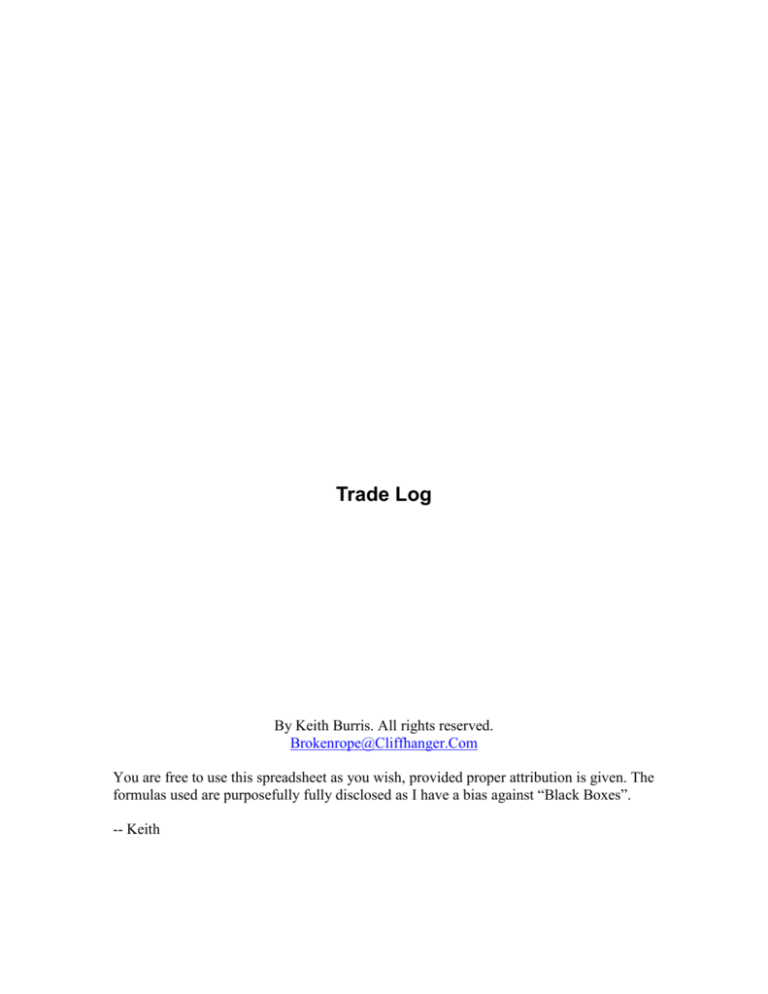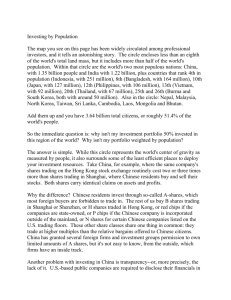
Trade Log
By Keith Burris. All rights reserved.
Brokenrope@Cliffhanger.Com
You are free to use this spreadsheet as you wish, provided proper attribution is given. The
formulas used are purposefully fully disclosed as I have a bias against “Black Boxes”.
-- Keith
Abstract ............................................................................................................................... 3
Requirements ...................................................................................................................... 3
The usage of Trade Log ...................................................................................................... 3
Strategy block ..................................................................................................................... 3
Statistics block .................................................................................................................... 3
Max High: ....................................................................................................................... 3
Max Low: ........................................................................................................................ 4
# Wins: ............................................................................................................................ 4
# Losses:.......................................................................................................................... 4
Profit Target: ................................................................................................................... 4
Positions: ......................................................................................................................... 4
Max Risk: ........................................................................................................................ 4
Avg. Win: ........................................................................................................................ 4
Avg. Loss: ....................................................................................................................... 4
Max Shares: .................................................................................................................... 4
Current Positions Open: .................................................................................................. 4
DDLR Ratio: ................................................................................................................... 4
W/L Ratio: ...................................................................................................................... 5
Margin %: ....................................................................................................................... 5
Perf/Day: ......................................................................................................................... 5
Days In System: .............................................................................................................. 5
Total Margin: .................................................................................................................. 5
Perf =: ............................................................................................................................. 5
Cost/Trade: ...................................................................................................................... 5
Beg. Bal.: ........................................................................................................................ 5
Initial Margin: ................................................................................................................. 5
$ Ret.: .............................................................................................................................. 5
Account Value: ............................................................................................................... 5
Amount Invested: ............................................................................................................ 5
Trading Log ........................................................................................................................ 6
Sym: ................................................................................................................................ 6
Date in: ............................................................................................................................ 6
Prev Close: ...................................................................................................................... 6
Price In: ........................................................................................................................... 6
Side: ................................................................................................................................ 6
Price Out: ........................................................................................................................ 6
% G/L on Trade: ............................................................................................................. 6
Shares: ............................................................................................................................. 6
G/L: ................................................................................................................................. 7
Profit/Loss: ...................................................................................................................... 7
Amount Invested: ............................................................................................................ 7
Target: ............................................................................................................................. 7
Suggested Trailing Stop: ................................................................................................. 7
Stop: ................................................................................................................................ 7
Risk: ................................................................................................................................ 7
Date Out: ......................................................................................................................... 7
Days In Trade:................................................................................................................. 7
A final note: .................................................................................................................... 7
Abstract
Trade Log is an Excel spreadsheet, which is designed to help you keep track of your
trading activities. This spreadsheet began its life as a tool to analyze some of the
preposterous claims made by investment gurus who are in the business of selling stock
trading signals. For example, many of these sites claim returns of 400% or more. Really?
What they ~really~ do is to add up the percentage gains and losses of each trade and post
those results as the returns you may enjoy by subscribing to their high priced subscription
services. This scheme does not address the real world of trading or a real world portfolio.
Consider – ABC Company signals a buy for IBM, INTC, and MSFT. Each of these trades
returns 5%. Ergo, they claim a return of 15%. This is pure horse pucky (yes, that’s a
technical term). In reality, if you had $30,000 to invest and you invested EQUALLY
($10,000) in each of the above trades, your portfolio would have increased by a total of
5%, not a bad return, but somewhat distanced from the posted 15%.
Requirements
This spreadsheet requires the use of the function “NETWORKDAYS”. This function is
distributed with Excel in the Analysis Tool Pak, but is not installed by default. See Excel
Help for instructions on adding the Analysis Tool Pak. If you are out of the USA, you
will need to create your own holiday’s file.
The usage of Trade Log
Trade Log is broken into three main parts, the strategy block, the statistics block and the
actual trading log.
Strategy block
This is nothing more than a free text area for you to write down your particular strategy, a
subscription service if you use one, entry and exit rules, etc. It is a place for YOU to
document YOUR method of making (or losing) money. If your strategy is successful, use
it. If it is not successful, save the spreadsheet so you can refer to it in the future and
hopefully not make the same mistake again. A cautionary note: You should paper trade
your strategy before committing real money.
Statistics block
First, notice that there are two different colors, a light blue and a somewhat darker blue.
The light blue fields are intended to not be mucked with, as the values they report are the
result of some calculation. The darker blue areas are those areas intended for user
inputted values. Most of the fields are documented as to what they are, but it is done here
again as well.
Max High:
The highest dollar returning trade.
Max Low:
The most negative returning trade.
# Wins:
The number of winning trades.
# Losses:
The number of losing trades.
Profit Target:
This is something for you to enter. Some people like to place two additional orders when
they enter the market, a ‘sell limit’ (profit) and a ‘stop loss’ order. This field allows you
to do ‘what if’ scenarios and have the ‘sell limit’ value calculated for you.
Positions:
This value will determine how much of your available trading funds will be allocated per
position. For example, if this value is one (1), 100% of your trading value will be
allocated for that one trade. If the value is two (2), 50% of available funds will be
allocated per trade. And so forth.
Max Risk:
You determine how much of your portfolio you want to ‘risk’ on each trade. This field is
used to calculate the Suggested Trailing Stop and the Stop.
Avg. Win:
Your average win.
Avg. Loss:
Your average loss.
The above two fields along with # Wins and # Losses are used to calculate the DDLR
(Discipline, Direction, Leverage, Risk) Ratio, a term coined by Robert Deel in “The
Strategic Electronic Day Trader”.
Max Shares:
Here we get a bit tricky. Perhaps you are a conservative investor, just getting his feet
wet, and you have a gut wrenching feeling when you see you are about to buy 68,700
shares of Berkshire Hathaway (there’s a joke here – look up Berkshire Hathaway. If you
can buy that much, you sure don’t need this spreadsheet!). Not to worry, you can use this
field to select 100 shares, 200 shares, you name it. This will limit your total exposure to
that many shares. Period.
Current Positions Open:
This just keeps track (a double check) of how many positions you have open.
DDLR Ratio:
Described above, this value should be above 3 to give you a warm and fuzzy feeling
about using margin.
W/L Ratio:
How many wins versus how many losses.
Margin %:
If you have a margin account (meaning you can sell short), you can specify how much of
that available margin you wish to use for trading. I recommend not using 100% (or 400%
if you are a day trader) as it provides you with no room if the position turns against you.
Can you say “Margin Call”?
Perf/Day:
This field keeps track of your rate of return on a daily basis,
Days In System:
How many days has this particular trade log existed? (Also uses the “NETWORKDAYS”
function).
Total Margin:
How many of the broker’s dollars do you have access to? This is an updated value as
your account balance increases.
Perf =:
The total performance of this trade log for the time it’s been in effect.
Cost/Trade:
This is the commission. Trade Log treats this value as times two since you pay this much
going into the trade and this much again when you exit.
Beg. Bal.:
This is your initial portfolio total amount.
Initial Margin:
The amount of margin you are committing on your first trade.
$ Ret.:
The number of dollars this strategy returned from start date to current.
Account Value:
The current value (after all profits and losses are summed) of your portfolio.
Amount Invested:
The total investment of all open positions.
Trading Log
This trading log is primarily an EOD trading log; which means you will be analyzing
signals and/or trading opportunities tonight, determining position sizing from available
data, and placing the trade, stop loss and profit limit tomorrow, in the morning at the
open of the market.
Sym:
The stock's symbol.
Date in:
Tomorrows date (or the next trading days date).
Prev Close:
Required to determine position sizing. It is the close at the end of trading today.
Price In:
This value will be filled in AFTER you have made the trade, the trade is executed and
you have a reported fill price. If you’re paper trading, you can make this value anything
you want.
Side:
There are only two possibilities here – Long or Short. A drop down widow will allow you
to choose.
Price Out:
This is the price you got when you exited the trade, from whatever means. Your exit
could have been caused by a stop or limit execution or because you felt like getting out of
the trade.
% G/L on Trade:
How the trade did. Returned automatically.
Shares:
To recapitulate – you enter the price of the close tonight, and the number of shares is
calculated for you based on margin, maximum allowed shares, account balance, positions
open, etc. Note that the price in amount may have warranted more or less shares, but the
idea is to have your order ready to go with but a finger press at the open, or to have
placed the order after hours before you know what the fill price will be. There rises a
problem at this point. Suppose you have entered in two trades and the first trade reaches a
profit limit and exits. You then update the trade log by entering in the price out field. This
causes your account balance to be recalculated and – behold – the number of shares in the
second trade has just increased as a result of the profit of the first trade, This can make it
a bit difficult to manage your portfolio properly. Therefore, YOU MUST - let me say
that again, YOU MUST hardcode the shares value in the shares field. So if the calculated
amount is 220 shares when you are doing your aftermarket analysis and preparing the
next days order, you MUST then type in the amount of 220. This will destroy the
calculation for that field and it will remain constant. This is a good.
G/L:
How the trade did after commissions.
Profit/Loss:
A running total of how your profit (hopefully) is doing.
Amount Invested:
This field is only populated while the trade is actually alive. It disappears once the trade
is closed.
Target:
This is the amount to use for a limit sell order (if long) based upon the Profit Target field
in the statistics block.
Suggested Trailing Stop:
A value determined by the Max Risk field in the statistics block. Only useful if you use
trailing stops.
Stop:
The suggested fixed stop, again based on the Max Risk field in the statistics block. Note
that this field may be changed as the trade progresses. It will affect the Risk field
(covered next).
Risk:
This value shows you, in dollars, about how much you may lose on the trade if you are
using the calculated stops (slippage is not accounted for). As the trade progresses and the
stop field is manually changed, this field will be updated to reflect the new risk (or locked
in profit).
Date Out:
A manually entered value of the date the trade was exited. Used to calculate the next
field.
Days In Trade:
Some people find it useful to know how many days the trade was in effect. This
calculation uses the “NETWORKDAYS” function.
A final note:
Actually there are two final notes.
1: I have propagated the formulas down to row 1000. So if you have more than a 1000
trades, be prepared to repopulate.
2: I am allowing the free use of this spreadsheet. By using it, you agree to certain terms.
The most stifling term you must agree to before using it is this: You hereby promise to
send me any improvements you make to the spreadsheet or – let me repeat that – or – any
bugs you find. I am not an excellent Excel programmer, and would like to get better. You
can help me in this endeavor.
3: Okay, I lied – there are three notes, so sue me. You will notice that the trade log is
setup as a split frame, meaning as the log increases in length, you do not scroll the
statistics block off the top of the screen.
4: I know, now I’m pushing it – well this one is short – Enjoy, and if you find this trade
log useful AND you have a strategy that is essentially the Holy Grail, IE a strategy that
returns huge profits with no drawdowns, then by all means, share it with me.
-- Keith Burris








